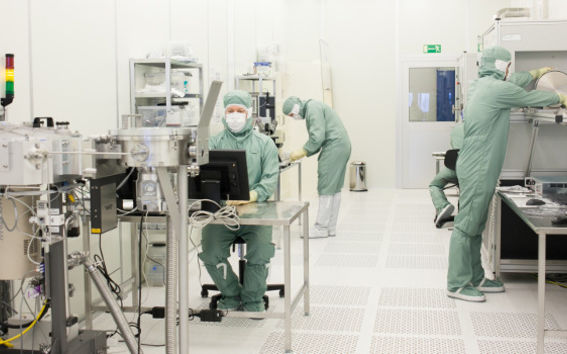About Micronova

Capability overview
Micronova’s facilities allow flexible processing and integration of micro- and nanoelectronic, micromechanical, photonic and fluidic devices. Substrate materials include silicon, III-V semiconductors, glass and quartz. The main wafer size is 150 mm, but also 200 mm and 100mm are supported for some processes. For some purposes even smaller samples are used. All necessary main process technologies are available, including optical and nanolithography, CMOS and BiCMOS, dry and wet etching, focused ion beam milling, micropackaging, wafer bonding, thin film processing and epitaxial deposition.
M1 cleanroom
The 'M1' Pilot plant is dedicated to research and manufacturing and it is operated by VTT to offer turn-key services to industry through contract research projects or services for manufacturing through the VTT Memsfab Oy subsidiary.
For the equipment located in the M1 cleanroom, please refer to the equipment database LIMS at: (link here).
The equipment in the M1 cleanroom are the tools with Tool Id's beginning with 1A - 1E and 1G - 1J.
M2 cleanroom
The 'M2' Nanofabrication cleanroom is a joint Aalto/VTT research facility with an open access policy, where process and measurement equipment can be used according to separate agreements by other universities, research institutes and companies.
The cleanliness ranges from ISO 7 (F13 "analysis lab") to ISO 4 (F8 "lithography").
For the equipment located in the M2 cleanroom, please refer to the equipment database LIMS at: (link here).
The tools with ID beginning with 1F or 2F are located in M2 cleanroom.
QEHS
Quality
VTT Nanofabrication Centre has been granted an ISO9001:2008 certificate for fabrication and small-volume production of materials and devices for micro-, nano- and optoelectronic applications, wafer processing subcontracting services and facility maintenance. The procedures described in the quality documentation apply also to the work performed by VTT Memsfab and any other parties using the cleanroom.
By working according to the guidelines we strive to continuously improve the services to our customers, reduce lot throughput time, improve yield and minimize process equipment downtime.
Our process registration database is the basis of the quality system. By logging all equipment use and maintenance we ensure full traceability of process steps, lot following and statistical data. Through monitoring of standard recipes we check the stability of the critical equipment.
Customer reclamations and internally detected problems are handled by the 8D-method. By implementing corrective and preventive actions we aim to prevent recurrence of non-conformities.
Through preventive actions and training we create a safe work environment and aim to prevent accidents.
ISO 14000
Health & Safety
Safety in the working environment is given high priority in Micronova Nanofabrication Centre. The main responsibility lies with the safety team both for personnel safety, alarm systems and equipment risk assessment.
The rescue team is trained for first aid and handling of any exceptional situations such as fire, gas leaks, chemical spills and accidents involving chemicals.
Fire protection is based on a sampling fire detection system covering the cleanrooms and plenum areas and an automatic water fog extinguishing system. Wet benches and fumehoods are protected by carbon dioxide extinguishing which is triggered by flame detectors.
The toxic gas alarm system utilizes electrochemical sensors and will give an alarm to evacuate the building upon detection of very small concentrations of toxic gases. The detectors are placed in gas cabinets, valve manifold boxes and other locations where leaks need to be detected. An alarm will also cause the gas cylinder to be shut-off. All cabinets and equipment in which toxic, explosive or corrosive gases are used are connected to a UPS supported exhaust system.
- Published:
- Updated: